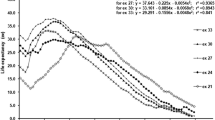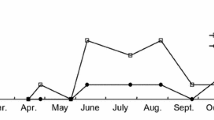Abstract
The intraspecific variation in larval instars is a widely distributed phenomenon amongst holometabolous insects. Several factors can affect the number of instars, such as temperature, humidity, and density. Only a few references could be found in the literature because the invariability in the number of larval instars is considered normal, and the issue has raised little to no interest. Despite this, no study to date has intended to assess or focus on the larval development. Here, we analyzed the effect of different rearing temperature on the larval stage of Dermestes maculatus DeGeer (Coleoptera: Dermestidae). The results indicated that at all temperatures, L5 represented a decisive point for individuals as well as the other later larval instars, because the next step to follow was to pupate or molt to the next larval instar. Furthermore, there were mainly two populations, L5 and L6, although in different proportions according to temperature. We also found that at a greater number of instars, the larval development at all temperatures lasted longer. Moreover, the exponential model was the best adjustment in the developmental time of all populations as well as for the accumulated developmental time of L1–L4. Thus, we conclude that random factors such as genetics could probably cause interspecific variability in D. maculatus larval development.





Similar content being viewed by others
References
Blanckenhorn WU (2000) The evolution of body size: what keeps organisms small? Q Rev Biol 75:385–407
Conover WJ (1980) Practical nonparametric statistics, 2nd edn. Wiley, New York, p 493
Esperk T, Tammaru T, Nylin S (2007) Intraspecific variability in number of larval instars in insects. J Econ Entomol 100:627–645
Ezenwaji HMG, Obayi NS (2004) The effect of fish moisture content on oviposition, fecundity and development of the hide beetle, Dermestes maculatus DeGeer (Coleoptera: Dermestidae). Anim Res Int 1:47–51
Haines CP, Rees DP (1989) Dermestes spp. A field guide to the types of insects and mites infesting cured fish. http://www.fao.org/docrep/003/t0146e/T0146E04.htm. Accessed 12 Jun 2010
Halstead DGH (1963) External sex differences in stored-products Coleoptera. Bull Entomol Res 54:119–134
Hinton HE (1945) A monograph of the beetles associated with stored products, vol 1. Trustees of the British Museum of Natural History, London, p 443
Hodson FRH, Chapco W (1986) Fitness traits associated with the red back phenotype in the migratory grasshopper, Melanoplus sanguinipes. Experientia 42:444–445
Honêk A (1993) Intraspecific variation in body size and fecundity in insects: a general relationship. Oikos 66:483–492
Jones D, Jones G, Hammock BD (1981) Growth parameters associated with endocrine events in larval Trichoplusia ni (Hübner) and timing of these events with developmental markers. J Insect Physiol 27:779–788
Mira A, Raubenheimer D (2002) Divergent nutrition-related adaptations in two cockroach populations inhabiting different environments. Physiol Entomol 27:330–339
Morita M, Tojo S (1985) Relationship between starvation and supernumerary ecdysis and recognition of the penultimate-larval instar in the common cutworm, Spodoptera litura. J Insect Physiol 31:307–313
Nagasawa S (1988) Number of larval instars of the gypsy moth in Japan (Lepidoptera: Lymantriidae). Appl Entomol Zool 23:441–448
Nijhout HF (1975) A threshold size for metamorphosis in the tobacco hornworm, Manduca sexta (L.). Biol Bull 149:214–225
Nijhout HF (1994) Insect hormones. Princeton University Press, Princeton, p 280
Osuji FNC (1975) The effects of salt treatment of fish on the developmental biology of Dermestes maculatus (Coleoptera, Dermestidae) and Necrobia rufipes (Cleridae). Entomol Exp Appl 18:472–479
PisfH ED, Korytkowski CG (1974) Biología y comportamiento de Dermestes maculatus DeGeer (Col.: Dermestidae). Rev Peru Entomol 17:28–31
Rhainds M, Ho CT (2002) Size-dependent reproductive output of female bagworms (Lepidoptera: Psychidae): implications for inter-generational variations of population density. Appl Entomol Zool 37:357–364
Richardson MS, Goff ML (2001) Effects of temperature and intraspecific interaction on the development of Dermestes maculatus (Coleoptera: Dermestidae). J Med Entomol 38:347–351
Tammaru T, Esperk T, Castellanos I (2002) No evidence for costs of being large in females of Orgyia spp. (Lepidoptera, Lymantriidae): larger is always better. Oecologia (Berl) 133:430–438
Taylor TA (1964) Observations on the biology and habits of Dermestes maculatus DeGeer a dried fish pest in Nigeria. Niger Agric J 1:12–16
Telfer MG, Hassall M (1999) Ecotypic differentiation in the grasshopper Chorthippus brunneus: life history varies in relation to climate. Oecologia (Berl) 121:245–254
Vidal Sarmiento MJ, Alzuet AB (1965) Insectos y otros artrópodos que atacan productos almacenados de origen animal. Rev Mus La Plata Zool 8:47–97
Zakka U, Ayertey JN, Cobblah MA (2013) Development of Dermestes maculatus (DeGeer, 1774) (Coleoptera, Dermestidae) on different fish substrates. Jordan J Biol Sci 6:5–10
Zanetti NI (2013) Estudio bionómico de la coleopterofauna de interés forense en condiciones naturales y controladas en el área de Bahía Blanca (Prov. Buenos Aires, Argentina). PhD. Thesis, Universidad Nacional del Sur, Bahía Blanca, Argentina, p viii + 292
Zanetti NI, Visciarelli EC, Centeno ND (2015) The effect of temperature and laboratory rearing conditions on the development of Dermestes maculatus (Coleoptera: Dermestidae). In press by J Forensic Sci
Acknowledgments
The authors wish to thank Lic. Ricardo Camina from the Universidad Nacional del Sur for his statistical advice. This work was funded by grants from Universidad Nacional de Quilmes and Universidad Nacional del Sur. Noelia I. Zanetti thanks CONICET for her fellowship.
Author information
Authors and Affiliations
Corresponding author
Additional information
Edited by Regiane C Freitas Bueno – UNESP
Rights and permissions
About this article
Cite this article
Zanetti, N.I., Visciarelli, E.C. & Centeno, N.D. Biological Strategies of Dermestes maculatus DeGeer (Coleoptera: Dermestidae) at Larval Stages in Different Temperatures. Neotrop Entomol 45, 652–657 (2016). https://doi.org/10.1007/s13744-016-0415-9
Received:
Accepted:
Published:
Issue Date:
DOI: https://doi.org/10.1007/s13744-016-0415-9




